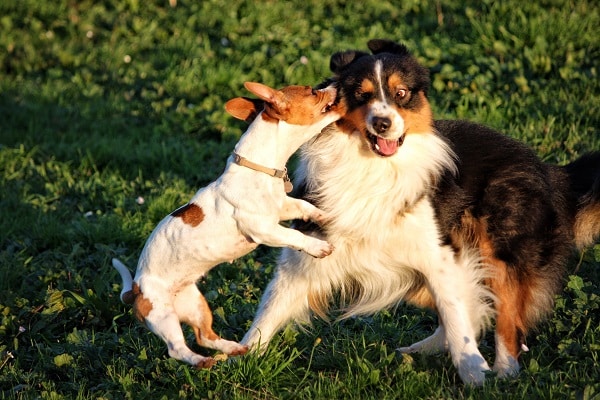Most pet owners will affirm that their dogs are expressive, communicating their feelings, needs, and intentions through an intricate language of barks, tail wags, postures, and facial expressions. But interpreting this language isn’t always straightforward, and misinterpretations can lead to confounding interactions and missed cues. That’s why it’s essential to understand canine body language, not only for the well-being of your furry friend but also to foster a stronger, more fulfilling relationship with them.
This extended article will discuss the basics of canine body language, delve into the subtleties of facial expressions and postures, debunk misconceptions about tail wagging, examine the nuances of vocalizations, explore the role of breed and individual differences, and even take a closer look at inter-dog communication.
The Basics Of Canine Body Language

Dogs are incredibly expressive creatures. Each body movement is a form of communication, from their playful bow to their nervous tail tucking. Understanding these signals can greatly enhance our relationship with our pets, enabling you to meet their needs better.
In the realm of canine communication, a fascinating concept is “calming signals.” Norwegian dog trainer, Turid Rugaas, identified these signals as ways dogs prevent aggression, calm down other dogs, and even comfort themselves. A yawn might not necessarily mean your dog is tired; it could be a calming signal. Remember, context is crucial in interpreting these signs accurately. Misinterpretation can sometimes lead to unnecessary conflict or stress for your furry pal.
Understanding Facial Expressions

Have you ever noticed your dog’s eyes soften when you gently stroke its fur or seen its ears perk up at the sound of a sizzling pan? A dog’s face, just like ours, is highly expressive. By paying close attention, you can gauge what your pet might feel at any moment.
A dog’s eyes will appear soft and relaxed in a peaceful state. But when agitated, the whites of their eyes may show, or they may give a hard stare. Similarly, a dog with erect ears is alert and paying attention, whereas one with flattened ears could be fearful. Observing these small yet significant details can provide valuable insights into your pet’s emotional world.
Reading Canine Posture

Like their facial expressions, a dog’s posture can tell a tale. For instance, a playful bow with a wagging tail and bouncing movement is a universal sign of playfulness. But not all canine postures are this easy to read.
Raised hackles, where the hair along a dog’s back stands up, can indicate arousal, fear, excitement, or uncertainty. It is not necessarily a sign of aggression. A tail between the legs usually signifies fear, anxiety, or submission. The key to understanding these postures lies in considering the overall body language and the context in which they occur.
Tail Wagging – Not Always a Sign of Happiness

Contrary to popular belief, a wagging tail doesn’t always signify a happy dog. The misconception might lead to unwarranted interactions, sometimes resulting in a nip or bite. Tail wagging is more about emotional arousal than any specific emotion.
The tail wag’s direction, speed, and position can convey a range of emotions. A high, stiff wag might indicate alertness or aggression, whereas a low, slow wag could indicate uncertainty or fear. In a situation where I thought Max was happily wagging his tail, he was, in fact, highly stressed about loud noise in the distance.
Vocalizations In Dogs

Just as humans use different tones of voice to express emotions and intentions, dogs communicate with various vocalizations. The nuanced symphony of barks, whines, growls, and howls can convey everything from excitement to distress.
A high-pitched, repetitive bark may indicate excitement or seeking attention, whereas a low growl could be a warning. Remember, it’s important not to suppress growls as they are crucial communication tools for dogs. However, it’s not just about the type of sound. The context, body language, and knowledge of your dog’s vocal habits are essential in accurately interpreting these vocalizations.
Body Language In Inter-Dog Communication

Have you ever watched two dogs meet at the park and wondered what their wagging tails, pricked ears, and sniffs communicate? Inter-dog communication is a complex dance of signals, where each movement conveys a message. When a dog meets another, it’s a symphony of signals at work – from the initial gaze to the final tail wag, each action communicates information about intentions, moods, and more.
A confident dog approaching another might have its tail held high, ears forward, and might even engage in a direct stare, all signs of asserting dominance. Conversely, a submissive dog might approach with its body lowered, tail tucked in, avoiding direct eye contact. Watching these interactions and recognizing how adeptly dogs navigate their social world is fascinating. Understanding these behaviors can also help prevent conflicts and promote harmonious dog relationships.
The Role of Breed and Individual Differences

Just as humans have unique ways of expressing themselves, dogs also have individual differences in body language. Factors such as breed, upbringing, and temperament can greatly influence their communication.
A herding breed, for example, might use intense stare as part of their instinctive behavior, while a retriever might communicate more with its mouth by carrying objects. Understanding breed traits can be helpful, but paying attention to your dog’s communication style is equally essential. As Max and his neighborhood friend, a Golden Retriever named Buddy, played, I noticed stark differences in their play styles, despite the similar context.
Conclusion
Understanding canine body language opens up a new way to connect with your dog. By learning this unique language, we can respond to our pets in ways that make them feel understood and loved, leading to a stronger bond. Whether identifying the subtle calming signals or debunking the myth of tail wagging, every bit of knowledge enhances our relationship with these amazing creatures.
Resources For Further Learning
If you’re keen on deepening your understanding of canine body language, a wealth of resources is available. Notable books include “On Talking Terms with Dogs: Calming Signals” by Turid Rugaas and “Canine Behavior: A Photo Illustrated Handbook” by Barbara Handelman. Websites such as the American Kennel Club and The Spruce Pets offer a wealth of articles on dog behavior. Also, consider attending local seminars or classes focusing on canine behavior. Understanding your dog’s body language is a rewarding journey that enhances your bond and enriches your shared experiences.